Higher Education Marketing: Strategies and Trends to Know
With college enrollment decreasing for the eighth year in a row, boosting your school’s marketing efforts is more important than ever. Your push should begin with educating yourself and your marketing team about current higher ed trends in student recruitment, then strategizing on how to put these trends to work for your college or university.
Finally, make sure to analyze results to see what works—and what doesn’t—in your refined college or university marketing plan.
Curious about effective ways to interact with prospective students? Download the 2019 E-Expectations® Trend Report for the latest digital engagement data.
Higher Education Marketing Trends for Student Recruitment
Today’s students are digital natives who not only spend more time daily on their digital devices than they do sleeping, but know how to use technology better than anyone on your marketing team.
If you’re trying to make your school’s message stand out, the following questions can guide you through trends that can aid your college or university marketing strategy.
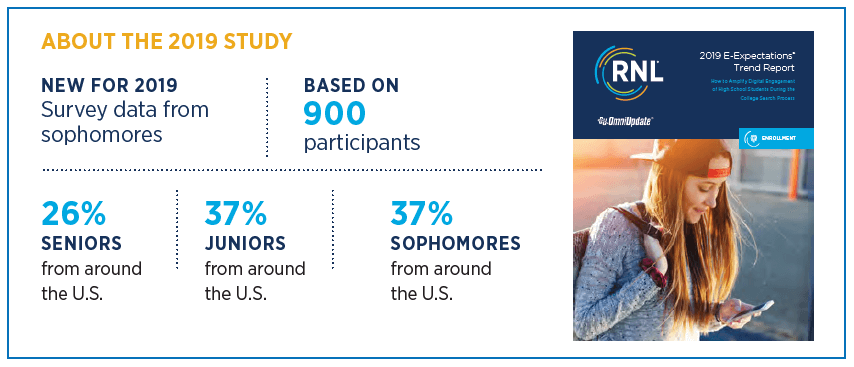
CAPTION = The 2019 E-Expectations Trend Report includes data from 900 sophomores, juniors, and seniors from around the U.S.
Source: 2019 E-Expectations Trend Report
What are the most influential higher education marketing resources in a student’s search?
Students in any grade tend to visit a school’s website first, but then complement their search with information from email, social media, video, and texts. Use your website to educate prospective students about everything your college or university has to offer, then go deeper with customized college tours, targeted emails, and even personal calls from admissions officers.
How can higher education marketers encourage interaction with high school seniors?
Overwhelmingly, prospective students will complete a form on your website to get more information. Other ways that students will interact with your college or university include listing the school on college assessment tests (SAT, ACT, etc.), emailing the school directly, and requesting information through college planning sites.
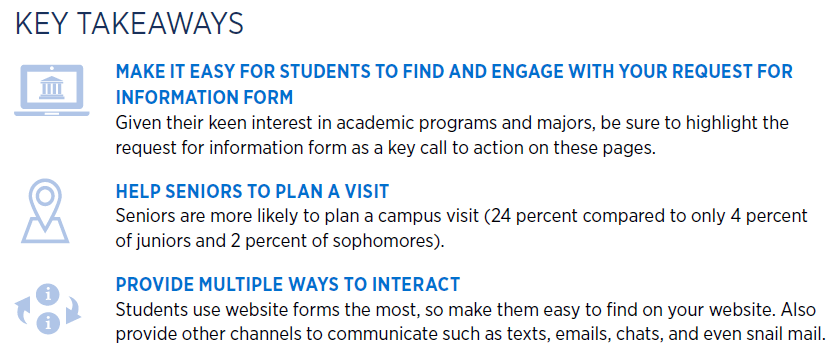
CAPTION = Campus visits and forms are among the ways to interact with prospective students.
Source: 2019 E-Expectations Trend Report
What social media platforms are best for higher education marketing?
All of them. Snapchat and Instagram are used most frequently by students on a daily basis, while parents continue to scroll through Facebook for their social media fix. For best results, create a marketing strategy using a mix of social media platforms for your school’s messaging.
Should university and college marketing strategies also target parents?
Parents continue to be involved in their student’s college decision, with 62% of students reporting that parents help them assess choices. Be sure your college marketing plan includes information that speaks directly to this important demographic.
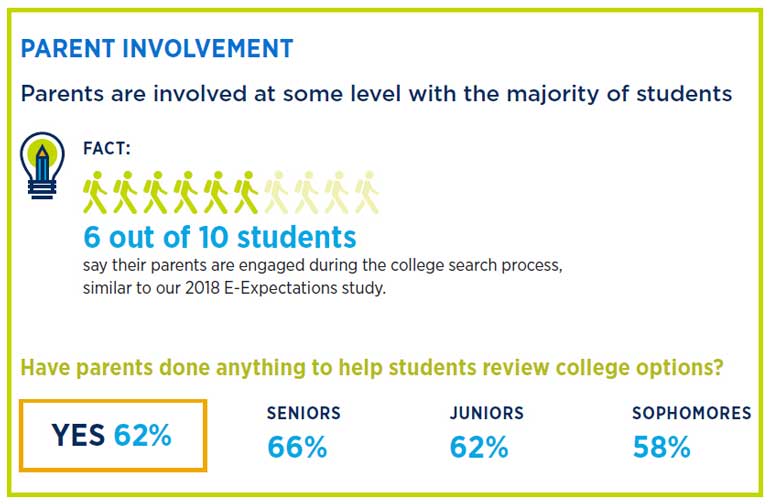
CAPTION = Six out of 10 students say parents are involved at some level in the college search process.
Source: 2019 E-Expectations Trend Report
Creating Your University Marketing Plan
With a solid understanding of current higher ed trends, you’re ready to devise a marketing plan for your college or university. Get input from other departments on campus and review your website to ensure that messaging and branding are cohesive with the plan you intend to implement.
Key questions to ask:
- Who is our target audience? Who are our personas?
- What are our KPIs for engagement?
- What is the cornerstone of our marketing plan or the most important thing for anyone interested in our college or university to know?
- What makes us different from other higher ed institutions?
What platforms will we use to market our offerings?
Interestingly, survey results from the 2019 E-Expectations Trend Report indicate that 74% of seniors report responding to text messages from colleges. For best results, try texting prospective students before an application deadline and after submitting an application, but also be sure to include other platforms in your marketing mix. These include:
- Social media (Twitter, Facebook, LinkedIn, Instagram, Snapchat)
- Direct mail
- Phone calls
- Website
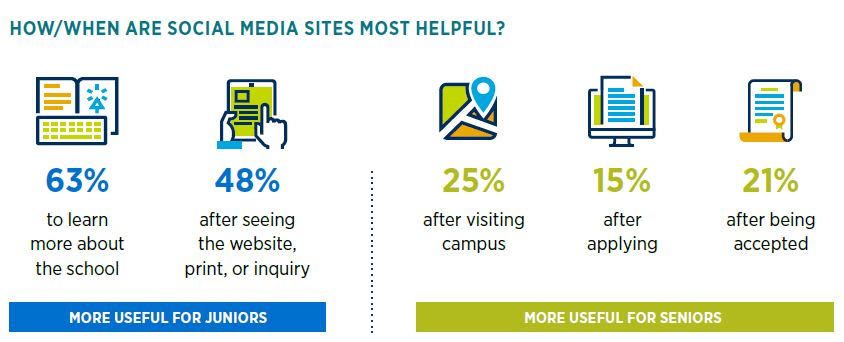
CAPTION = According to the 2019 E-Expectations Trend Report, social media sites are more helpful to prospective students when they want to learn more about a school.
Source: 2019 E-Expectations Trend Report
Higher Education Marketing Strategies for Your College or University
Reaching prospective students is a challenge given the amount of media they are inundated with on a daily basis. However, the more you can understand what they expect from digital technology and how they interact with it, the stronger your recruiting and marketing efforts will be. The following strategies can help you tailor a higher education marketing plan that best meets the needs of your college or university—and your prospective students.
Higher Ed Marketing Strategy 1: Use a content management system built for higher education.
Implementing a quality web content management system (CMS) designed specifically for colleges and universities can eliminate many of your school’s digital marketing challenges, including:
- Content that is dated and stagnant. A redesign may give your website a new look, but a CMS gives it life. A quality system will help you manage content efficiently and effectively, making it easier for your marketing strategy to live up to its long-term potential.
- A website that requires complicated coding to make changes. When considering a new CMS, look for one that allows non-technical users to organize, create, and manage digital content without complicated coding.
- Inconsistent messaging and branding. Branding should be built into the actual design of your website and “fixed” so that general content contributors can’t modify design elements like color that could affect brand consistency.
- Low search rankings. A quality CMS should make it easy to update page titles, descriptions, and meta tags, all of which help to optimize content for search engines so that your college or university is findable.
Thousands of your peers can’t be wrong—request a demo to see why so many choose Omni CMS to power their websites.
Higher Ed Marketing Strategy 2: Get current students involved.
Peer-to-peer communication is one of the easiest and most realistic ways for a prospective student to get a grip on what it’s like to be on your campus. Ask existing students to write blog posts, provide testimonials, and take over your social media to show day-in-the-life experiences on campus. Take note: students are also experts at discerning what’s real, so don’t try to fake your way with staged or stock photos. Be as authentic as possible.

– Image courtesy of Texas Christian University
Higher Ed Marketing Strategy 3: Choose a CMS with an email marketing module.
Blanket emails get deleted, but personalized, targeted emails get noticed by prospective students. A whopping 98 percent of prospective students will share an email address.
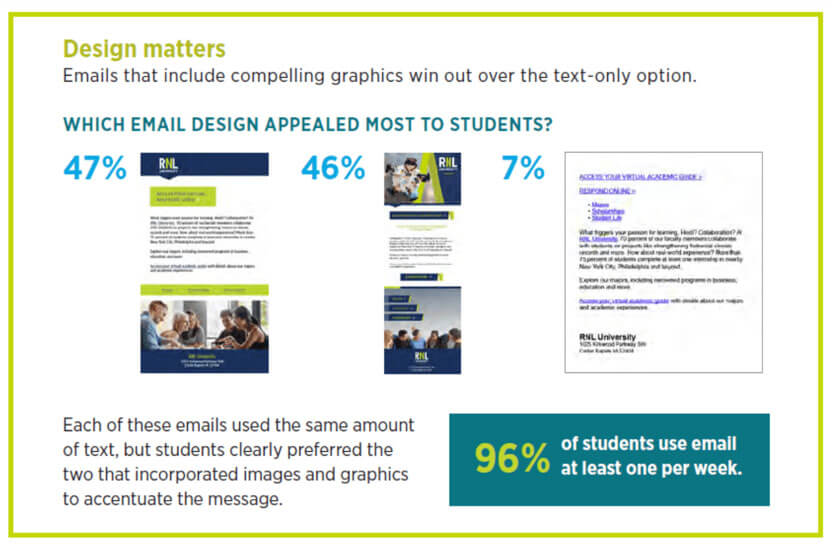
CAPTION = Emails with compelling graphics win out over the text-only option. Source: 2019 E-Expectations Trend Report
Higher Ed Marketing Strategy 4: Keep track of your brand.
What is your school’s social media image? What do students and fans share? When the news is positive, social media is a great way to market your college or university, but when something less appealing is shared about your school, you’ll want to know sooner than later so that you can address it head on.
Higher Ed Marketing Strategy 5: Focus on video content.
Video content has become an essential component to student recruitment strategies. Sophomores, juniors, and seniors all rate video highly as a way to learn more about a particular college or university. When putting together your marketing strategy, consider:
- Integrating video into social and on your website. Videos embedded into your website help prospective students visualize certain aspects of college and university life, while videos on social media publicize current happenings on campus.
- Livestreaming events unique to your campus such as sporting events, lectures, student activities, and campus traditions.
- Adding live cams at popular campus locations. This allows prospective students to “drop in” and see what’s happening in various locations on campus at any given time.
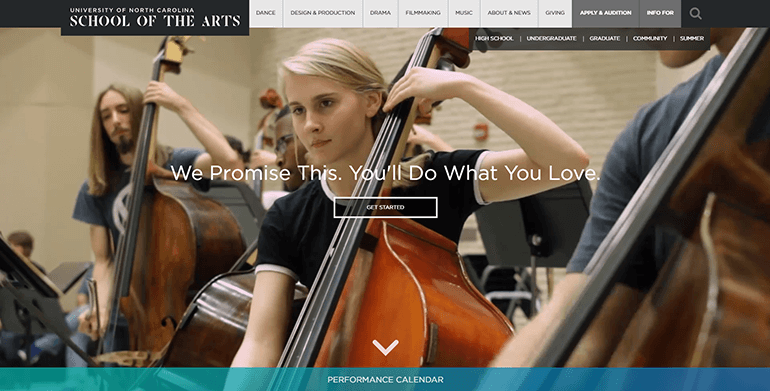
CAPTION = University of North Carolina School of the Arts’ home page showcases stunning footage from student performances and rehearsals—giving prospective students a glimpse into what it’s like to study dance, design and production, drama, filmmaking, and music at the school.
Conclusion
Don’t wait to make your website great. The latest data and a quality CMS can help you fine-tune your college or university marketing strategy for success.
Get the data: Download the 2019 E-Expectations Trend Report to see what high school students say about college digital engagement strategies.
Download the 2019 E-Expectations Trend Report
Last updated: February 5, 2021


